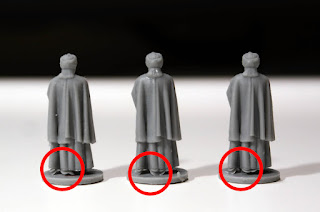 |
| Indus Culture Set 1 |
 |
| Bacchanalia in Ancient Rome Set 1 |
The figures in both sets require a bit of clean up with a hobby knife, as traces of the supports remain on the figures in various places. The Indus Culture set however, had a lot more issues.
Several of the figures were wet looking and sticky, particularly on the bases. I wasn't sure if it was uncured resin, so I tried putting them under a UV light which seemed to reduce the stickiness a bit (but it may have just been my imagination).
The stuff didn't seem to wash off with isopropanol, so I scraped the base with a knife to remove the stickiness. This is not a good solution for other parts of the miniatures which were affected though. I may try scrubbing with soap and water later.
On many of the figures, the hems of the garments were ill-formed or incompletely printed.
What was really egregious however, were the malformed scales held by the merchant figure.
I used CA glue and baking soda to build up the bottom of the pans, then filed them into shape using the only properly printed figure as a reference.
 |
| The good, the bad, and the restored. |
The servant holding a fan comes in two parts. The resin is not really flexible enough to allow the fan to slot into place easily, so I ended up shaving down the pegs on the hands holding the fan before trying to attach it to the figure.
The Indus Culture set consists of 40 figures in 10 poses.
Despite the various printing issues, they are very nice figures. The dancing girl figure is clearly based on the bronze statue of the Mohenjo-daro Dancing Girl. Other figures seem to be based on illustrations from Ornament Styles of the Indus Valley Tradition (Kenoyer, 1992).
The Bacchanalia set also consists of 40 figures in 10 poses (kind of). PSR claims the set is pornography, and refuses to show pictures, but whatever.
According to PSR, the set is based on the movie Caligula, but almost all the figures are completely nude, which I don't really think was the case in any of the relevant scenes from the film.
One of the figures is clearly based on the Priapus with Caduceus fresco from Pompeii, while the tibicen player is perhaps based on the left panel relief of the Ludovisi Throne (maybe).
Given the limited utility of these figures, I think that Linear A should cut down on the number of figures per set, reduce the price accordingly, and increase their quality control.













































